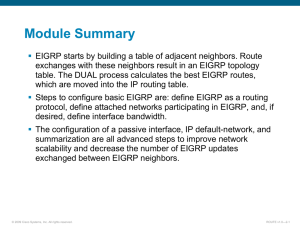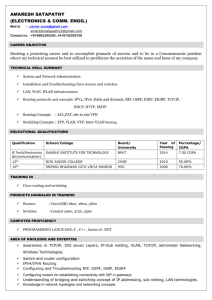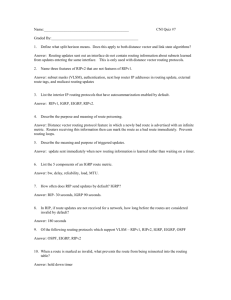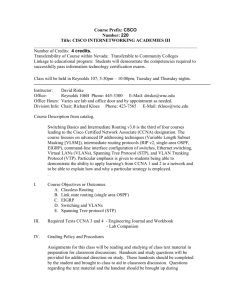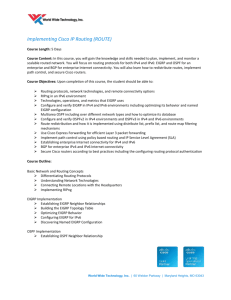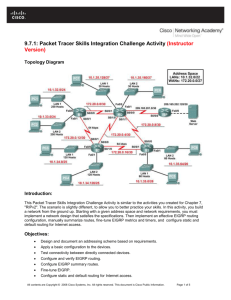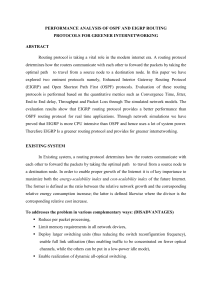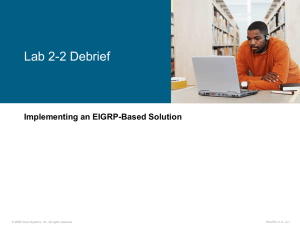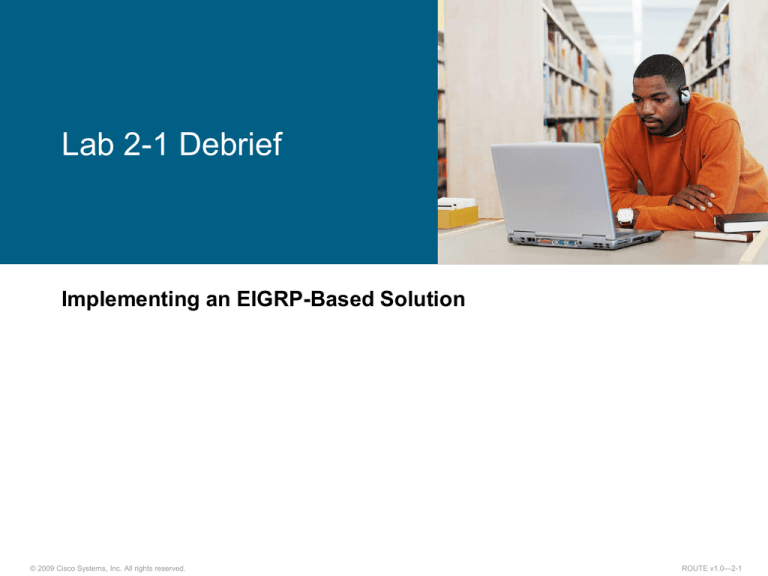
Lab 2-1 Debrief
Implementing an EIGRP-Based Solution
© 2009 Cisco Systems, Inc. All rights reserved.
ROUTE v1.0—2-1
Lab Topology
© 2009 Cisco Systems, Inc. All rights reserved.
ROUTE v1.0—2-2
Lab Review: What Did You Accomplish?
Task 1: Configure Basic EIGRP
– What steps did you take to configure the EIGRP routing
protocol and advertise all of the specific IP subnets used in the
network?
Task 2: Influence EIGRP Path Selection
– What must be changed so that the primary path is preferred
and the secondary path remains as a backup?
Task 3: Optimize EIGRP Operation
– How do you prevent the formation of an adjacency, as well as
preserve interface bandwidth and CPU resources?
Task 4: Scale EIGRP Operation
– How is summarization configured in order to improve
convergence time and add to stability?
© 2009 Cisco Systems, Inc. All rights reserved.
ROUTE v1.0—2-3
Verification
Did you have enough information to create the implementation
plan?
Do the EIGRP-enabled routers form the adjacencies?
Do you see all of the EIGRP-advertised networks in the IP routing
table as EIGRP routes?
Do you see two routes in the IP routing table after manipulating
the path where the correct one is preferred?
You cannot see the adjacency where the EIGRP routing protocol
packets are suppressed, but the path to the destination still exists
via another route; why is this?
Do you see a summary route to Null0 interface as well as many
more-specific subnets?
© 2009 Cisco Systems, Inc. All rights reserved.
ROUTE v1.0—2-4
Checkpoints
Configure the EIGRP routing protocol
Advertise only specific subnets used in the network
Manipulate the path by changing the metric
Ensure the backup path still exists in the IP routing table
Suppress the EIGRP routing protocol packet to preserve interface
bandwidth and CPU resources without filtering
Enable manual summarization to hide more specific subnets and
improve stability
© 2009 Cisco Systems, Inc. All rights reserved.
ROUTE v1.0—2-5
Sample Solution
EIGRP is configured on the routers.
Specific subnets used in the network are advertised.
The metric for the link between routers R1 and R3 is changed.
The LAN interfaces on routers R1 and R3 are configured as passive.
Summarization is configured on router R1.
© 2009 Cisco Systems, Inc. All rights reserved.
ROUTE v1.0—2-6
Alternative Solutions
EIGRP can be configured per interface or globally
Different metrics, administrative distance, and filtering can be applied
Static routes can be used and EIGRP can be disabled between
routers R1 and BBR1.
The use of another routing protocol can be an alternative solution,
which is not realistic.
© 2009 Cisco Systems, Inc. All rights reserved.
ROUTE v1.0—2-7
Q and A
Why is routing protocol selection important?
Why is changing the metric important?
Does filtering preserve CPU router resources?
Why does the passive-interface command result in no adjacency
between the routers?
Why does summarizing the router IP routing table contain a
summary route to Null0 as well as more specific subnets?
Why do the IP routing tables for some routers contain only a
summary route?
© 2009 Cisco Systems, Inc. All rights reserved.
ROUTE v1.0—2-8
Summary
Configure EIGRP and advertise all of the specific IP subnets in
the network.
Influencing EIGRP Path Selection can be applied by using a
changing metric and backup path still exists in the IP routing table.
By suppressing EIGRP routing packets, an EIGRP adjacency is
not formed and the routing updates are not exchanged which
results in more interface bandwidth and less CPU cycles used.
Summarization decreases the size of the IP routing table, as only
the summary route is present. The summarizing router has a
summary route to the Null0 interface, as well as routes to morespecific subnets.
© 2009 Cisco Systems, Inc. All rights reserved.
ROUTE v1.0—2-9
© 2009 Cisco Systems, Inc. All rights reserved.
ROUTE v1.0—2-10



